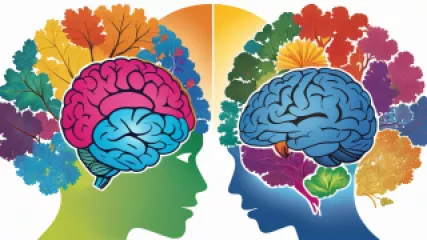The Ultimate Guide to Embracing Neurodiversity
Embracing Neurodiversity: A Transformative Journey
In a world that often values conformity, the concept of neurodiversity stands as a powerful reminder that diversity is not only natural but essential. Neurodiversity celebrates the unique ways in which our brains are wired, acknowledging that there is no single "normal" mode of cognitive functioning. This paradigm shift has the potential to transform the way we approach mental health, education, and our understanding of the human experience.
Unveiling the Beauty of Neurodiversity
Neurodiversity is a term that encompasses a wide range of neurological differences, including Autism Spectrum Disorder (ASD), Attention Deficit Hyperactivity Disorder (ADHD), Dyslexia, Dyspraxia, and Tourette Syndrome, among others. These variations in cognitive processing, sensory processing, and social-emotional functioning are not flaws or deficits, but rather, unique expressions of the human brain's remarkable diversity.
At the heart of neurodiversity lies the understanding that each individual's brain is wired differently, and that these differences are not inherently better or worse, but simply different. This perspective challenges the traditional medical model that has often viewed neurological variations as disorders or disabilities that require "fixing." Instead, the neurodiversity movement embraces these differences as natural and valuable, recognizing the strengths and contributions that neurodiverse individuals can bring to our communities.
Breaking Down Myths and Misconceptions
One of the key challenges in embracing neurodiversity is addressing the myths and misconceptions that have long surrounded it. These negative stereotypes and assumptions can create barriers to understanding, acceptance, and the empowerment of neurodiverse individuals.
For example, the common misconception that all autistic individuals are socially isolated or intellectually disabled ignores the vast spectrum of experiences and abilities within the autistic community. Similarly, the notion that ADHD is simply a lack of focus or discipline overlooks the unique cognitive strengths and perspectives that individuals with ADHD often possess.
By challenging these harmful narratives and actively promoting a deeper understanding of neurodiversity, we can create a more inclusive and supportive environment for all individuals, regardless of their neurological differences.
Empowering Neurodiverse Individuals
Embracing neurodiversity is not just about awareness and acceptance; it's about actively empowering neurodiverse individuals to thrive and reach their full potential. This involves creating accessible and inclusive environments, providing tailored support and accommodations, and celebrating the unique strengths and contributions of neurodiverse individuals.
In the realm of education, for example, this might mean offering specialized teaching methods, assistive technologies, and flexible learning environments that cater to the diverse needs and learning styles of neurodiverse students. In the workplace, it could involve providing sensory-friendly workspaces, flexible schedules, and mentorship programs to empower neurodiverse employees to excel in their roles.
By empowering neurodiverse individuals and recognizing their value, we not only improve their quality of life but also enrich our communities with the diverse perspectives, talents, and innovations that they have to offer.
Embracing Neurodiversity in Mental Health
The field of mental health has been a particularly significant battleground in the fight for neurodiversity. Traditionally, mental health professionals have often approached neurological differences through a medical lens, focusing on "treating" or "curing" perceived deficits. However, the neurodiversity movement challenges this approach, advocating for a more holistic, strengths-based understanding of mental health.
Rather than pathologizing neurological variations, the neurodiversity model encourages mental health professionals to recognize the unique experiences, needs, and strengths of neurodiverse individuals. This includes providing tailored support, therapies, and interventions that empower neurodiverse individuals to manage their challenges while celebrating their gifts.
By shifting the focus from "fixing" neurological differences to empowering neurodiverse individuals, the mental health field can play a crucial role in fostering greater understanding, acceptance, and inclusion for all.
Creating a Neurodiverse-Inclusive Society
Embracing neurodiversity is not just an individual endeavor; it requires a collective societal shift. This means actively dismantling the systemic barriers and biases that have long marginalized neurodiverse individuals, and creating a more inclusive and accessible world for all.
This might involve advocating for policy changes that protect the rights and interests of neurodiverse individuals, whether in education, employment, or access to public services. It could also mean challenging the media's portrayal of neurodiversity, ensuring that neurodiverse individuals are accurately and sensitively represented.
Ultimately, creating a neurodiverse-inclusive society requires a holistic approach that addresses societal attitudes, institutional practices, and the personal lived experiences of neurodiverse individuals. By embracing neurodiversity as a fundamental aspect of human diversity, we can build a more just, equitable, and enriching world for all.
Embracing Your Neurodiversity
The journey of embracing neurodiversity is deeply personal, and it begins with the individual. Whether you identify as neurodiverse or simply seek to better understand and support the neurodiverse individuals in your life, the first step is to cultivate self-awareness and self-acceptance.
This might involve exploring your own unique cognitive and sensory processing patterns, celebrating your strengths, and learning to navigate your challenges with compassion. It may also mean educating yourself about the diverse experiences and perspectives within the neurodiverse community, and actively working to dismantle the stigma and misconceptions that often surround neurological differences.
By embracing your own neurodiversity or that of your loved ones, you can become a powerful advocate and ally in the movement towards greater inclusion and understanding. Together, we can create a world where neurological differences are celebrated, empowered, and integrated into the fabric of our communities.
Conclusion: A Brighter Future for All
The embrace of neurodiversity represents a profound shift in our understanding of the human experience. By recognizing and celebrating the rich diversity of our brains and minds, we can unlock a world of untapped potential, innovation, and collective growth.
Through education, advocacy, and the empowerment of neurodiverse individuals, we can build a more inclusive, equitable, and fulfilling society that benefits us all. It is a journey of transformation, one that challenges us to expand our perspectives, confront our biases, and cultivate a deeper appreciation for the beautiful tapestry of human diversity.
As we embark on this path, let us remember that embracing neurodiversity is not just about acceptance – it is about actively creating a world where everyone can thrive, where our unique strengths and perspectives are celebrated, and where the richness of the human experience is celebrated in all its forms.
By embracing neurodiversity, we open the door to a brighter future – one where everyone has the opportunity to reach their full potential, to contribute their unique gifts, and to find their place in the world. It is a future filled with possibility, empowerment, and the boundless joy of human diversity.






